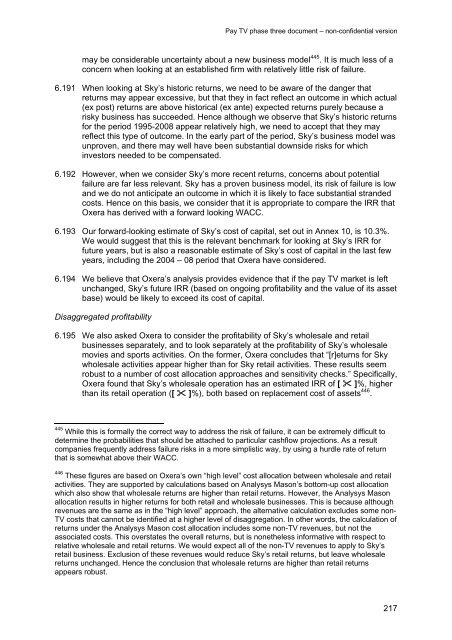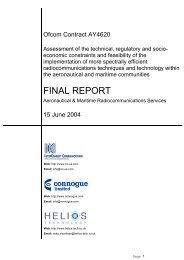Pay TV phase three document - Stakeholders - Ofcom
Pay TV phase three document - Stakeholders - Ofcom
Pay TV phase three document - Stakeholders - Ofcom
You also want an ePaper? Increase the reach of your titles
YUMPU automatically turns print PDFs into web optimized ePapers that Google loves.
<strong>Pay</strong> <strong>TV</strong> <strong>phase</strong> <strong>three</strong> <strong>document</strong> – non-confidential version<br />
may be considerable uncertainty about a new business model 445 . It is much less of a<br />
concern when looking at an established firm with relatively little risk of failure.<br />
6.191 When looking at Sky’s historic returns, we need to be aware of the danger that<br />
returns may appear excessive, but that they in fact reflect an outcome in which actual<br />
(ex post) returns are above historical (ex ante) expected returns purely because a<br />
risky business has succeeded. Hence although we observe that Sky’s historic returns<br />
for the period 1995-2008 appear relatively high, we need to accept that they may<br />
reflect this type of outcome. In the early part of the period, Sky’s business model was<br />
unproven, and there may well have been substantial downside risks for which<br />
investors needed to be compensated.<br />
6.192 However, when we consider Sky’s more recent returns, concerns about potential<br />
failure are far less relevant. Sky has a proven business model, its risk of failure is low<br />
and we do not anticipate an outcome in which it is likely to face substantial stranded<br />
costs. Hence on this basis, we consider that it is appropriate to compare the IRR that<br />
Oxera has derived with a forward looking WACC.<br />
6.193 Our forward-looking estimate of Sky’s cost of capital, set out in Annex 10, is 10.3%.<br />
We would suggest that this is the relevant benchmark for looking at Sky’s IRR for<br />
future years, but is also a reasonable estimate of Sky’s cost of capital in the last few<br />
years, including the 2004 – 08 period that Oxera have considered.<br />
6.194 We believe that Oxera’s analysis provides evidence that if the pay <strong>TV</strong> market is left<br />
unchanged, Sky’s future IRR (based on ongoing profitability and the value of its asset<br />
base) would be likely to exceed its cost of capital.<br />
Disaggregated profitability<br />
6.195 We also asked Oxera to consider the profitability of Sky’s wholesale and retail<br />
businesses separately, and to look separately at the profitability of Sky’s wholesale<br />
movies and sports activities. On the former, Oxera concludes that “[r]eturns for Sky<br />
wholesale activities appear higher than for Sky retail activities. These results seem<br />
robust to a number of cost allocation approaches and sensitivity checks.” Specifically,<br />
Oxera found that Sky’s wholesale operation has an estimated IRR of [ � ]%, higher<br />
than its retail operation ([ � ]%), both based on replacement cost of assets 446 .<br />
445 While this is formally the correct way to address the risk of failure, it can be extremely difficult to<br />
determine the probabilities that should be attached to particular cashflow projections. As a result<br />
companies frequently address failure risks in a more simplistic way, by using a hurdle rate of return<br />
that is somewhat above their WACC.<br />
446 These figures are based on Oxera’s own “high level” cost allocation between wholesale and retail<br />
activities. They are supported by calculations based on Analysys Mason’s bottom-up cost allocation<br />
which also show that wholesale returns are higher than retail returns. However, the Analysys Mason<br />
allocation results in higher returns for both retail and wholesale businesses. This is because although<br />
revenues are the same as in the “high level” approach, the alternative calculation excludes some non-<br />
<strong>TV</strong> costs that cannot be identified at a higher level of disaggregation. In other words, the calculation of<br />
returns under the Analysys Mason cost allocation includes some non-<strong>TV</strong> revenues, but not the<br />
associated costs. This overstates the overall returns, but is nonetheless informative with respect to<br />
relative wholesale and retail returns. We would expect all of the non-<strong>TV</strong> revenues to apply to Sky’s<br />
retail business. Exclusion of these revenues would reduce Sky’s retail returns, but leave wholesale<br />
returns unchanged. Hence the conclusion that wholesale returns are higher than retail returns<br />
appears robust.<br />
217
















